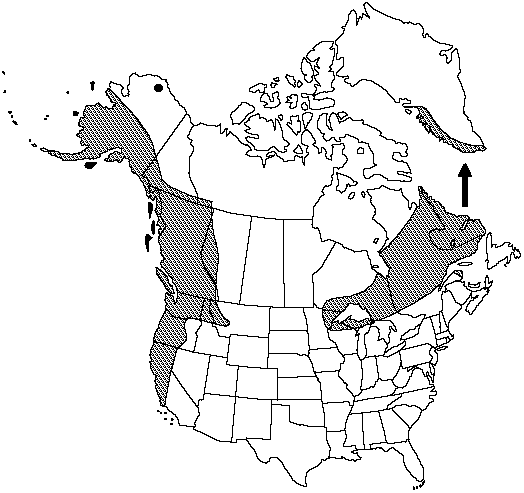Difference between revisions of "Dryopteris expansa"
Brit. Fern Gaz. 11: 338. 1977.
FNA>Volume Importer |
FNA>Volume Importer |
||
| Line 26: | Line 26: | ||
}}<!-- | }}<!-- | ||
| − | --><span class="statement" id="st- | + | --><span class="statement" id="st-undefined" data-properties=""><b>Leaves </b>monomorphic, tardily dying back in winter, to 90 × 30 cm. <b>Petiole</b> 1/3 length of leaf, scaly at least at base; scales scattered, brown with dark brown stripe. <b>Blade</b> green, deltate-ovate, 3-pinnate-pinnatifid, herbaceous, usually not glandular, occasionally finely and densely glandular. <b>Pinnae</b> ± in plane of blade, lanceolate-oblong; basal pinnae deltate, slightly reduced, basal pinnules equal to or longer than adjacent pinnules, basal basiscopic pinnule longer than basal acroscopic pinnule; pinnule margins serrate. <b>Sori</b> midway between midvein and margin of segments. <b>Indusia</b> lacking glands or sparsely glandular. <b>2n</b> = 82.</span><!-- |
-->{{Treatment/Body | -->{{Treatment/Body | ||
| Line 55: | Line 55: | ||
|publication year=1977 | |publication year=1977 | ||
|special status= | |special status= | ||
| − | |source xml=https://jpend@bitbucket.org/aafc-mbb/fna- | + | |source xml=https://jpend@bitbucket.org/aafc-mbb/fna-data-curation.git/src/9216fc802291cd3df363fd52122300479582ede7/coarse_grained_fna_xml/V2/V2_405.xml |
|genus=Dryopteris | |genus=Dryopteris | ||
|species=Dryopteris expansa | |species=Dryopteris expansa | ||
| − | |||
| − | |||
| − | |||
| − | |||
| − | |||
| − | |||
| − | |||
| − | |||
| − | |||
| − | |||
| − | |||
| − | |||
| − | |||
| − | |||
| − | |||
| − | |||
| − | |||
| − | |||
| − | |||
| − | |||
| − | |||
| − | |||
| − | |||
| − | |||
| − | |||
| − | |||
}}<!-- | }}<!-- | ||
-->[[Category:Treatment]][[Category:Dryopteris]] | -->[[Category:Treatment]][[Category:Dryopteris]] | ||
Revision as of 13:19, 27 July 2019
Leaves monomorphic, tardily dying back in winter, to 90 × 30 cm. Petiole 1/3 length of leaf, scaly at least at base; scales scattered, brown with dark brown stripe. Blade green, deltate-ovate, 3-pinnate-pinnatifid, herbaceous, usually not glandular, occasionally finely and densely glandular. Pinnae ± in plane of blade, lanceolate-oblong; basal pinnae deltate, slightly reduced, basal pinnules equal to or longer than adjacent pinnules, basal basiscopic pinnule longer than basal acroscopic pinnule; pinnule margins serrate. Sori midway between midvein and margin of segments. Indusia lacking glands or sparsely glandular. 2n = 82.
Habitat: Cool moist woods and rocky slopes
Elevation: 50–1500 m
Distribution

Greenland, Alta., B.C., Nfld., N.W.T., Ont., Que., Yukon, Alaska, Calif., Idaho, Mich., Minn., Mont., Oreg., Wash., Wis., Wyo., Europe.
Discussion
Dryopteris expansa is diploid and is one of the parents of D. campyloptera. Where their ranges overlap in eastern Canada, these two species are very difficult to distinguish except by chromosome number. The growth habit (D. expansa leaves are more erect) is useful in the field. Three hybrids involving D. expansa are known; all are very rare.
Selected References
None.